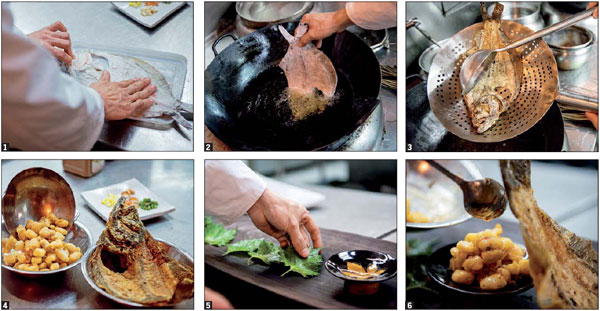For love of the fish
Updated: 2013-04-12 16:52
By Liu Jue (China Daily)
|
||||||||

From monogamy to marinade, the taste of the love fish
Ancient Chinese people would never have dreamed of eating flounder 左口鱼 (zuǒkǒuyú, left-mouth fish). For one, the flounder was believed to be a symbol of devoted lovers. In modern Chinese cuisine, however, flounder is common and is well known for its high nutritional value.
The flounder is known by different names in different parts of China. In the north, it's called 偏口鱼 (piānkǒuyú, one sided-mouth fish). Guangzhou natives, renowned experts in the art of seafood, call it the "left-mouth fish" instead. Some call the flounder by its more archaic namesake: 比目鱼 (bǐmùyú, fish with eyes close together).
Obviously, these names all come from the flounder's unusual look, and it was this appearance that led to the inspiration for its associated romantic fantasies. As a flat fish, the flounder swims horizontally, with both its eyes on the same side. The ancient Chinese assumed it would be difficult for the flounder to swim alone because it seems like only half a fish. As such, they believed that the flounder needed a lifetime partner in order to navigate its way through the inky darkness of the deep.
When describing the fish, the earliest dictionary, Erya (《尔雅》, Approaching the Correct) from the Han dynasty (206 BC-AD 220), stated: "In the east sea, there is a fish whose eyes are close together. It can not swim unless in pairs, and its name is die". Thus, flounders became associated with loyal couples and became a symbol representing the idiom "比目连枝"(bǐmù liánzhī, flounders and twinned branches, representing devoted couples).
The Tang dynasty (AD 618-907) poet Lu Zhaolin (卢照邻) used the flounder metaphor to describe a perfect romance: "I am dying to be with my beloved like a flounder; I would rather live a happy life with my lover like a pair of yuanyang birds than to envy the immortals" (得成比目何辞死, 愿作鸳鸯不羡仙。Dé chéng bǐmù hécísǐ, yuàn zuò yuānyāng búxiàn xiān). There is even a Chinese opera called《比目鱼》about two star-crossed lovers in the Qing dynasty (1644-1911) by literary master Li Yu (李渔).
In the ancient world, the lack of knowledge led to the imagination and mythology of the perfect flounder couple. Flounder can currently be found in the north of the Yellow Sea (黄海 Huánghǎi) and Bohai (渤海), China's continental sea. It is said that the best flounder comes from Qinhuangdao (秦皇岛), a coastal city on Hebei province. Nowadays, the flounder is no longer a rare dish on Chinese tables. As an essential ingredient in Cantonese cuisine (粤菜yuècài), the dried flounder is called 大地鱼 (dàdìyú, earth fish). Boiled with pork bones, it adds delicate flavors (鲜味 xiānwèi) to various soups, including the famous wonton noodle soup (云吞面 yúntūnmiàn).
For this dish, we will fry the marinated flounder in flour, which, according to our guest chef Wu Xianfei (吴贤飞) from Beijing's Green T. House, is a Chinese neoclassic (新古典主义 xīngǔdiǎn zhǔyì) dish with modern flavors.
Courtesy of The World of Chinese,
www.theworldofchinese.com
The World of Chinese
|
Photos Provided to China Daily |

 In Photos: 7.0-magnitude quake hits Sichuan
In Photos: 7.0-magnitude quake hits Sichuan
 Li Na on Time cover, makes influential 100 list
Li Na on Time cover, makes influential 100 list
 FBI releases photos of 2 Boston bombings suspects
FBI releases photos of 2 Boston bombings suspects
 World's wackiest hairstyles
World's wackiest hairstyles
 Sandstorms strike Northwest China
Sandstorms strike Northwest China
 Never-seen photos of Madonna on display
Never-seen photos of Madonna on display
 H7N9 outbreak linked to waterfowl migration
H7N9 outbreak linked to waterfowl migration
 Dozens feared dead in Texas plant blast
Dozens feared dead in Texas plant blast
Most Viewed
Editor's Picks

|

|

|

|

|

|
Today's Top News
Live report: 7.0-magnitude quake hits Sichuan, heavy casualties feared
Boston suspect cornered on boat
Cross-talk artist helps to spread the word
'Green' awareness levels drop in Beijing
Palace Museum spruces up
First couple on Time's list of most influential
H7N9 flu transmission studied
Trading channels 'need to broaden'
US Weekly

|

|








